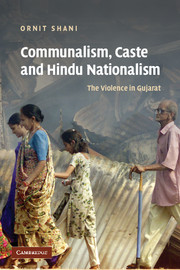Book contents
- Frontmatter
- Contents
- Acknowledgements
- Glossary
- List of abbreviations
- Map of Ahmedabad
- Introduction
- Part I The background
- Part II The 1985 Ahmedabad riots: the historical conjunction between caste conflicts and communalism
- Part III The making of ethnoHinduism
- 5 The making of ethnoHinduism: from the politics of redistribution to the politics of recognition
- 6 The role of violence in ethnic politics
- Bibliography
- Index
5 - The making of ethnoHinduism: from the politics of redistribution to the politics of recognition
Published online by Cambridge University Press: 04 December 2009
- Frontmatter
- Contents
- Acknowledgements
- Glossary
- List of abbreviations
- Map of Ahmedabad
- Introduction
- Part I The background
- Part II The 1985 Ahmedabad riots: the historical conjunction between caste conflicts and communalism
- Part III The making of ethnoHinduism
- 5 The making of ethnoHinduism: from the politics of redistribution to the politics of recognition
- 6 The role of violence in ethnic politics
- Bibliography
- Index
Summary
The ideas of a unitary ‘Hindu identity’ and Hindu nationalism began gaining support in Ahmedabad from the 1980s in the context of intensifying conflicts among Hindus. This chapter explores the factors that brought about this shift. The analysis shows that the rising communal antagonism against Muslims and support for Hindu nationalism was largely driven by the way in which diverse groups of Hindus experienced caste and its changing character, and in particular by deepening uncertainties within the Hindu moral order. These dynamic processes were related to state policies and politics. Caste and its relations to the state, therefore, are a critical factor in the rise of Hindu nationalism and the growth of communal antagonism since the 1980s. This chapter provides a conceptual framework for understanding the relations between communalism and caste and their interplay with the state, which came to a head in the 1985 riots. Communalism and caste should be understood as practices of ethnic politics. Hindu nationalist ideologies, ordinarily assumed to be rooted in religious difference and communal conflict, should be more accurately seen as a discourse and practice of ethnic politics, or what will be describe here as ethnoHinduism.
The chapter begins by providing a framework for thinking of ethnic identity formation and the practice of ethnic politics. The following three sections present an analysis of the making of ethnoHinduism in relation to caste, the state and violence.
The designation and usage of communalism have become a way of ‘describing the tendency of South Asian people to divide along an Islamic–Hindu breakdown’ as a ‘substitute for true nationalism’.
- Type
- Chapter
- Information
- Communalism, Caste and Hindu NationalismThe Violence in Gujarat, pp. 135 - 155Publisher: Cambridge University PressPrint publication year: 2007

